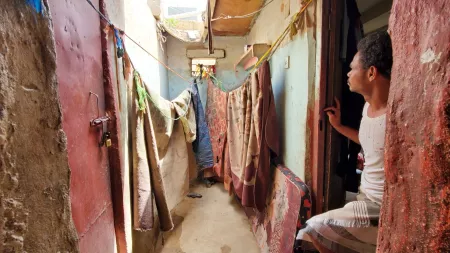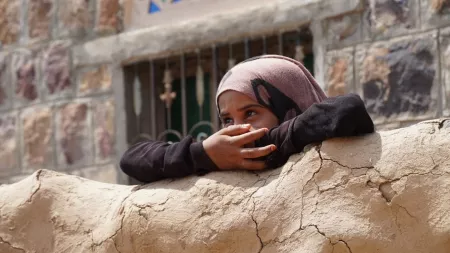Today, 26 March 2023, the people of Yemen enter the ninth year of conflict since its escalation in 2015. The conflict in Yemen has left nearly no aspects of life in the country untouched, leading to one of the world's worst humanitarian crises. The Global Peace Index 2022 ranked Yemen as the second least peaceful country in the world, after Afghanistan, and its conflict remains one of the deadliest for civilians by global measures. In this article, we share snapshots of 8 stories that tell how Yemenis' lives have been affected after nearly a decade of war.
Refugees in their own homeland
With nearly 4.5 million people displaced since 2015, Yemen faces the sixth largest internal displacement crisis globally. Although internal displacement offers relative protection from direct fighting, it poses significant challenges and risks to displaced families forced to live in poor living conditions without enough food, water, healthcare, and other essentials. Many families have experienced displacement multiple times.
“Before displacement, I used to work as a farmer and owned livestock,” says Zabn Allah Ali, a 37-year-old father of 5 children who, together with his family, has experienced displacement 6 times. “My life was good back then. Yet after displacement, my life became hard, and I lost most of my livestock, and I can barely provide necessities for my family who live in a humble makeshift tent in the middle of desert land.”
Watch story: Displaced again and again – Yemeni IDP family struggling to meet basic needs
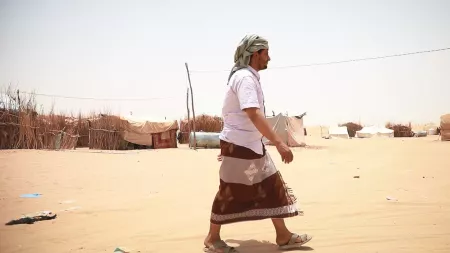
Women bearing the brunt
Women and girls in Yemen have often been among those most vulnerable to the devastating effects of conflict. The eight year long crisis has heightened existing risks affecting women as they continue to disproportionately bear the consequences of the crisis, including experiencing high levels of displacement, challenges accessing services, and compounded forms of violence. Nearly 26 percent of displaced households are headed by women. The conflict, intense deprivation, and lack of services have left many women in charge of providing and caring for their families with little education, vocational training, or sources of income.
Salma* is one of over one million internally displaced persons (IDPs) who sought refuge in one of Marib’s displacement sites. She gets up early every morning to herd the few sheep she managed to take before she fled the fighting in her hometown. Tragically, Salma’s husband and son were killed in the fighting 7 years ago, and she became the family's sole protector and provider. She lives with her 7 children and her mother-in-law in a humble makeshift shelter.
“I only had one blanket which I used as a mattress and another to cover all my children with for warmth. I used to spread the blanket on the ground, put my children in parallel on one side of the blanket, and then fold it over to cover them with the remaining to keep them warm during the night,” says Salma.
Read the story: Scaling up urgent support for displaced families in Marib
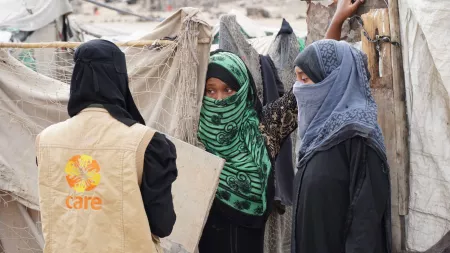
A bleak future looms for Yemeni children
“We, the generation who were born in the war, are oppressed in many ways, especially in terms of education,” says Nawarah, a 15-year-old student in tenth grade. “We don’t have safe schools, nor chairs, boards, or medicine at schools. All this has distracted our attention while attending classes, and we haven’t been able to fully focus on our lessons.”
During conflicts, children suffer first and suffer most, and the conflict in Yemen has had its toll on children's education and well-being. More than half of the 23.4 million people in need in Yemen are children. A child dies every 9 minutes in Yemen due to preventable diseases, malnutrition, displacement, and conflict. An estimated 2.2 million children under 5 require treatment for acute malnutrition that is likely to stunt their growth.
Over two million school-age Yemeni girls and boys are out of school as poverty, conflict and lack of opportunities disrupt their education. When children are out of school, they face many risks and challenges, which can have dire consequences on both their present and their future. Boys and girls deprived of education are more likely to be trapped in a cycle of poverty and unfulfilled potential for the rest of their lives. They are more likely to be victims of violence, child labor and early marriage.
Read the story: From under trees into classrooms: Yemeni students remain determined to learn despite all odds
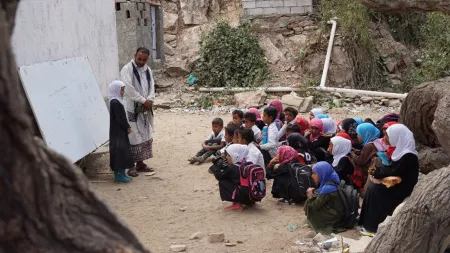
The threat of hunger stalks more than half of the population
Amal is a 35-year-old widowed mother of 5. With no proper education or training, Amal singularly bears the responsibility for the family. “My children and I often go to sleep hungry because we don't have food,” she says.
To cope with the need to feed her children with no source of income, Amal was forced to marry off her eldest daughter at a young age. “My daughter wanted to continue her education and become a doctor, but I could not pay for her food or education. So she got married at the age of fifteen. This makes me very sad, but I had no other solution. I know my daughter should be playing at this age and I deprived her of her childhood, but life is not fair to us poor people.”
“My daughter was pregnant when she was still 15, and due to poor nourishment and her weak body, she lost her baby during her eighth month of pregnancy, which also caused her health complications. Currently, my daughter is 17 years old and is 5 months pregnant. I am afraid that she will be exposed to risks and complications again. I hope nothing happens to her,” says Amal.
According to the UN's World Food Programme, 17.4 million Yemenis are food insecure – a number that is also projected to reach 19 million. In a country that imports nearly 90 percent of its food, pressures on international supply chains stemming from the crisis in Ukraine has
heightened global food insecurity and contributed to increased food prices in Yemeni markets.
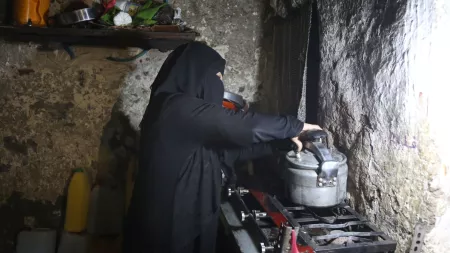
A dire water shortage crisis
Even before the current conflict, Yemen was one of the world’s most severely water stressed countries. The conflict has overshadowed the alarming water scarcity problems in the country. Additionally, the gradual depletion of water sources and desertification — brought on by agricultural pressures, recurrent drought and climate change — threaten the availability of arable land and access to clean, drinkable water for millions of Yemenis.
“I’ve been in living in this camp for three years,” says 52-year-old Mohammed Saad, who left his home in Al Hodeidah Governorate and sought refuge with his family in a displacement camp in Aden. “All families here suffer from the uncovered and unclean water wells. However, we endured walking long distances to fetch water from these wells. People used to struggle to find clean water, and children and women became weak from fetching water. Even donkeys would often die after one year of fetching water,” he says.
Read the story: Providing clean water to displaced families in Aden
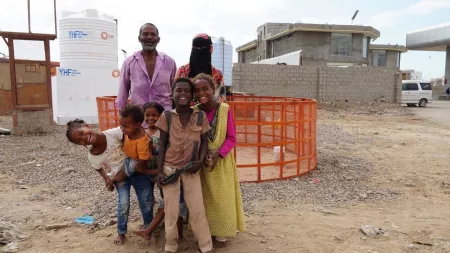
Healthcare system on the brink of collapse
“Our living condition deteriorated more after the war,” says Adnan, a 25-year-old man who lives with his family in Dhamar Governorate, south of the capital, Sana’a. Adnan was born well and healthy but was diagnosed with meningitis at the age of 13. Despite 2 years of treatment, the illness took away his hope of being able to walk again and left him paralyzed and suffering from renal failure. “My little body couldn’t bear the large amount of medications I had to take which led to renal failure. I had to drop out of school in the eighth grade due to my health condition,” he says.
“My father lost his job and couldn’t pay for my treatment and medication,” adds Adnan. “Fuel shortage has had a negative effect on governmental hospitals which provide treatment to kidney failure patients. This reduced the number of my dialysis sessions.” He states that sometimes he arrives at the hospital and has to wait until the electricity is back to start his session. “Sometimes I wish I had never been born,” Adnan laments.
Only half of all health facilities across Yemen are fully functioning, while 21.9 million people need support to access critical health services. The conflict has contributed to significant outbreaks of communicable diseases, including vaccine-preventable diseases, such as cholera, diphtheria, dengue, measles, and the resurgence of vaccine-derived polioviruses. Moreover, the COVID-19 pandemic has further worsened the health situation. Staff shortages, inadequate supplies and equipment, inability to meet operational costs and power outages caused by lack of fuel, put the lives of millions at risk.
Read the story: Helping a young man receive treatment and renewing hope
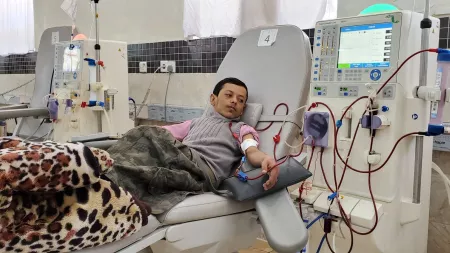
Gripped by a devastating economic decline
The widespread instability and insecurity across the country have devastated infrastructure systems and public services, further deepening the humanitarian and economic crisis. Years of conflict and economic recession have eroded the resilience of Yemeni families, forcing them to adopt negative coping strategies, such as running up debts, selling possessions, and begging.
"My salary wasn’t enough to provide basics for my family,” says Bashir Nasser, a 42-year-old father of 4. Bashir works as a teacher, but due to inflation and the increasing prices of basic commodities and services, he was struggling to provide minimum necessities for his family. As a result, Bashir started to run up large debts. “I used to buy food and other basic items on credit from a grocery store," he says. “Eventually, the owner of that grocery shop refused to give me any items because my debt was large, and I couldn’t pay it off."
Read the story: Promoting economic resilience of vulnerable communities in Yemen
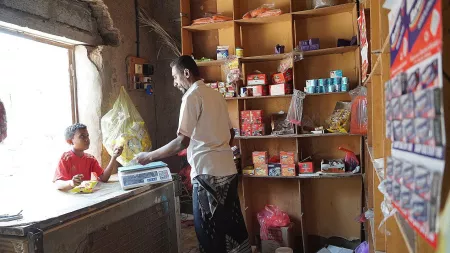
Climate change threatens the future of the war-scarred country
Climate change and extensive environmental destruction caused by protracted conflict threaten to exacerbate existing vulnerabilities in Yemen. According to the INFORM Climate Change Risk Index for 2022, Yemen ranks third among the most vulnerable countries to climate change and least prepared for climate shocks, after Somalia and South Sudan. In 2022, Yemen experienced two successive extreme weather events, ranging from severe drought conditions to heavy rainfall and flooding. Both floodings and drought risk lives, livelihoods and the well-being of Yemen's population, often contributing to displacement and increased vulnerability while putting additional pressure on infrastructure and essential services.
“I would have never thought that one day I would be uprooted from my hometown and have to start over as a displaced person in a new place,” says Mohammed, a 40-year-old father of 2 who fled the fighting in Al Hodeida and was displaced to Amran Governorate.
“I rented a derelict house in Amran’s countryside, yet this year’s heavy flooding destroyed the roof of the house. The rain has also damaged some of my furniture and I can’t afford to pay to have it repaired. I’ve given up on thinking about whether I need to provide food for my family or stop the rain flooding our home,” says Mohammed.
Read the story: Life-Saving Assistance Package aims to mitigate impact of floods on the internally displaced population in Amran Governorate
